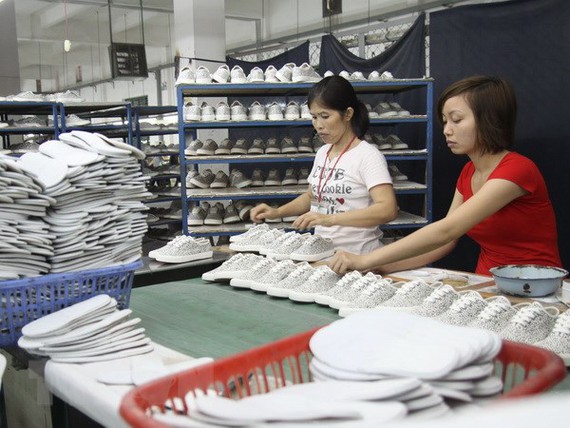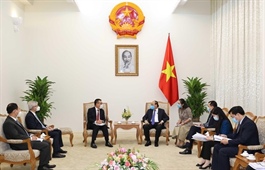Vietnam must review its global trade in future
Vietnam must review its global trade in future
Vietnam saw a record high trade surplus in the first ten months of 2020, which touched almost USD 18.72 bn. However, the relationship with major trading partners still remains imbalanced, especially with the USA and China. Nonetheless, Vietnam's trade activities in recent years have seen many positive changes.
Illustrative photo.
|
Record trade surplus
In the first ten months of 2020, the General Statistics Office (GSO) in Vietnam reported a record high trade surplus of USD 18.72 bn, in which trade surplus in September was USD 3.5 bn and in October it was USD 2.2 bn. This is a positive sign in the current Covid-19 pandemic scenario, with the world raging and reeling under many difficulties and uncertainties that never existed before.
Export and import turnover in first ten months continued to increase at the rate of USD 229.27 bn, up 4.7% and USD 210.55 bn, up 0.4%. The main items contributing to the trade growth were machinery, equipment, spare parts, electronics, computers and components. On the other hand, consumer goods such as textiles, footwear, phones and components saw a sharp decline.
The US and China are the two largest export markets for Vietnam with a turnover of USD 62.3 bn and USD 37.6 bn, respectively. As for other trading partners, Vietnam's exports to the EU, ASEAN, Japan and South Korea decreased by 3%, 11.6%, 7% and 2.6%, respectively.
The relationship between Vietnam and the USA and China is in sharp contrast. Vietnam's exports to the US are growing rapidly, reaching a trade surplus of USD 50.7 bn compared to 2010 when they were only at about USD 12.4 bn. Vietnam still has trade deficit with China with an import turnover of USD 65.8 bn and a trade deficit of USD 28.2 bn. In addition, imports to other important trading partners have decreased, such as with South Korea they were down 5.3%, with ASEAN they were down by 8.5%, and with the US they were down by 2.4%.
Lessons to learn
China's way of overcoming the crisis caused by the Covid-19 pandemic and other uncertainties in the world such as the trade war, prove their way of functioning is much different to that of the United States. Interestingly, China's trade activity soared and contributed about 15% to GDP in the first nine months of 2020, while cumulative exports increased by 0.5%.
This was due to the rapid recovery of manufacturing and industrial units, which are back to functioning at the same level as pre-pandemic days. Whereas, the United States is still struggling to survive. In addition, China has established a new global style multilateral structure, undermining the leading role of the US on the world stage.
It can be seen that the trade war so far has mainly focused on China. This is merely encouraging trade to redirect to other countries instead of protecting, expanding and enhancing production capacity in the US. Even President Trump's aim in this trade war was directed towards China only. Thus, the US sparked trade war was a mere rivalry between two super powers.
The graph shows a strong trade shift between the US, China and Vietnam since the trade war struck in 2018 and the Covid-19 pandemic in 2020, with Vietnam's highest value at 310.1 in August 2020, and China at the same time at 105.8. However, it should be noted that the results from this graph may still cause the US to question whether Vietnam is a trans-shipment place of countries being sanctioned by the US.
Vietnamese trade in future
Vietnam is currently one of the economies with the largest openness in trade in the world with more than 200% of GDP, so any fluctuations in the global economy have certain impact on the domestic economy.
Vietnam's trade activities in the first ten months of 2020 have seen positive changes, despite facing disadvantages from the Covid-19 pandemic, but Vietnam's recent global integration can bring economic benefits, at least in the short term. Specifically, Vietnam has signed the Comprehensive and Progressive Agreement for Trans-Pacific Partnership (CPTPP), Free Trade Agreement (EVFTA), and Investment Protection Agreement (EVIPA) with the European Union.
Most recently on 15 November 2020, Vietnam signed a Regional Comprehensive Economic Partnership (RCEP) with other ASEAN countries and Australia, China, Japan, South Korea, and New Zealand. As the ASEAN 2020 Chair, perhaps Vietnam signed this agreement with the aim of targeting ASEAN multilateral connectivity rather than the benefits gained from the RCEP as most of the countries participating in this agreement have already signed commercial cooperation with Vietnam.
However, it is necessary to be careful with the agreements that have the participation of China as Vietnam's trade deficit has continuously increased in the past. Combined with the trend of VND appreciating against the CNY, it has put pressure on the trade balance between Vietnam and China. Chinese goods would then be cheaper and flood into Vietnam, putting pressure on domestic businesses to face fierce competition at home. In addition, it also leads to price competition and market shares of Vietnamese exporters in global trade.

























